| dc.contributor.author | Leising, Shelby | en |
| dc.date.accessioned | 2017-10-02T22:47:10Z | |
| dc.date.available | 2017-10-02T22:47:10Z | |
| dc.date.issued | 2014-06 | en |
| dc.identifier.uri | archives.northwestu.edu/handle/nu/25751 | |
| dc.description.abstract | The purpose of this study is to find a significant connection between rhythmic movements in the retention of additional math facts. Therefore, my research question is: Is there a significant difference between rhythmic movement, general movement, and non-movement in the memorization and retention of addition facts. I performed a quantitative experimental design study, focused on three groups: non-movement, general movement and rhythmic movement. The results from my study indicated that rhythmic movement played a role in heightening recall memory, but movement in general had a significance impact in increasing scores from test one to test two. In Conclusion, recall memory and retention are significantly increased when general movement is used in additional math facts. | en |
| dc.format.extent | iv, 29 pages | en |
| dc.format.medium | PDF | en |
| dc.language.iso | en | en |
| dc.publisher | Northwest University | en |
| dc.rights | This original work is protected by copyright. Copyright is retained by the author(s). Works may be viewed, downloaded, or printed, but not reproduced or distributed without author(s) permission. | en |
| dc.rights.uri | http://archives.northwestu.edu/page/copyright | en |
| dc.subject | Mathematics | en |
| dc.title | Retention and Rhythmic Movement in Additional Math Facts | en |
| thesis.degree.name | Master in Teaching | en |
| thesis.degree.level | Masters | en |
| thesis.degree.grantor | Northwest University | en |
| thesis.degree.discipline | College of Education | en |


 Maintained by the Northwest University Library
Maintained by the Northwest University Library